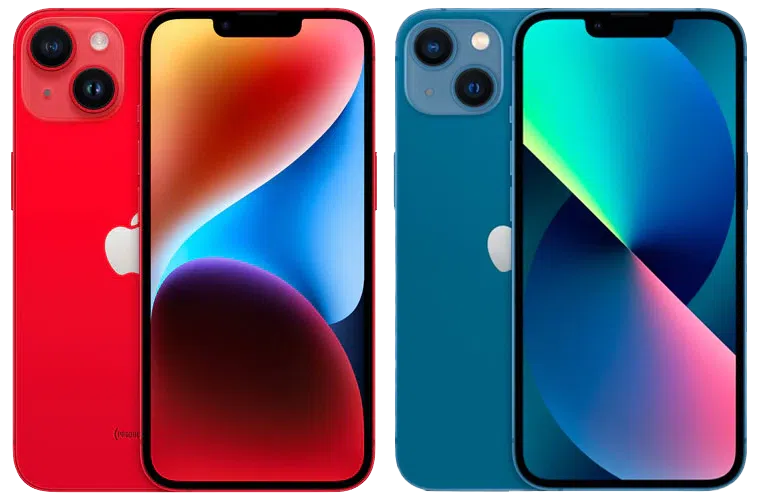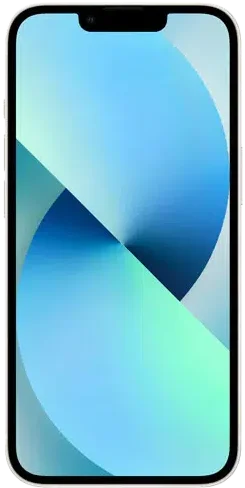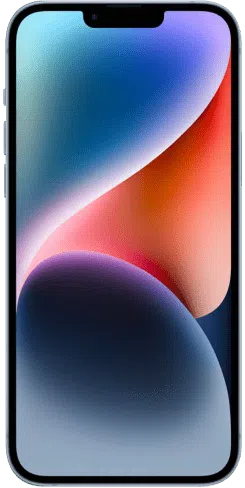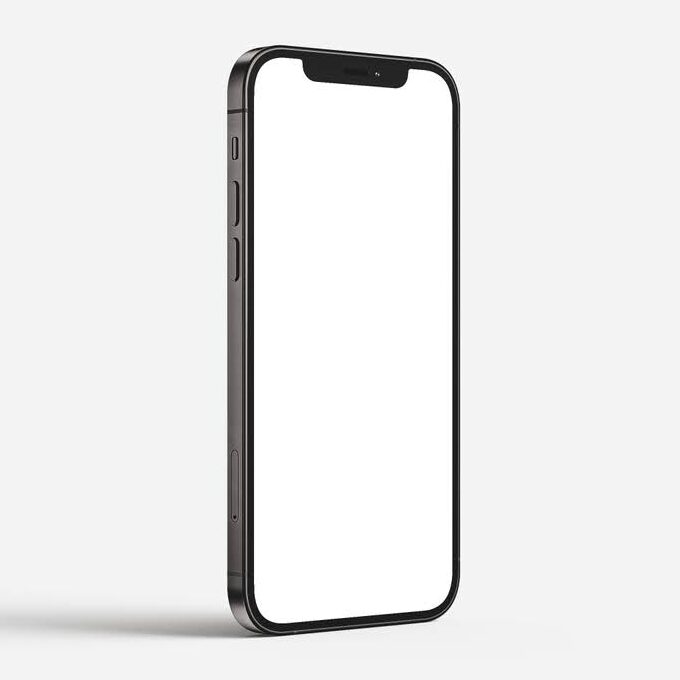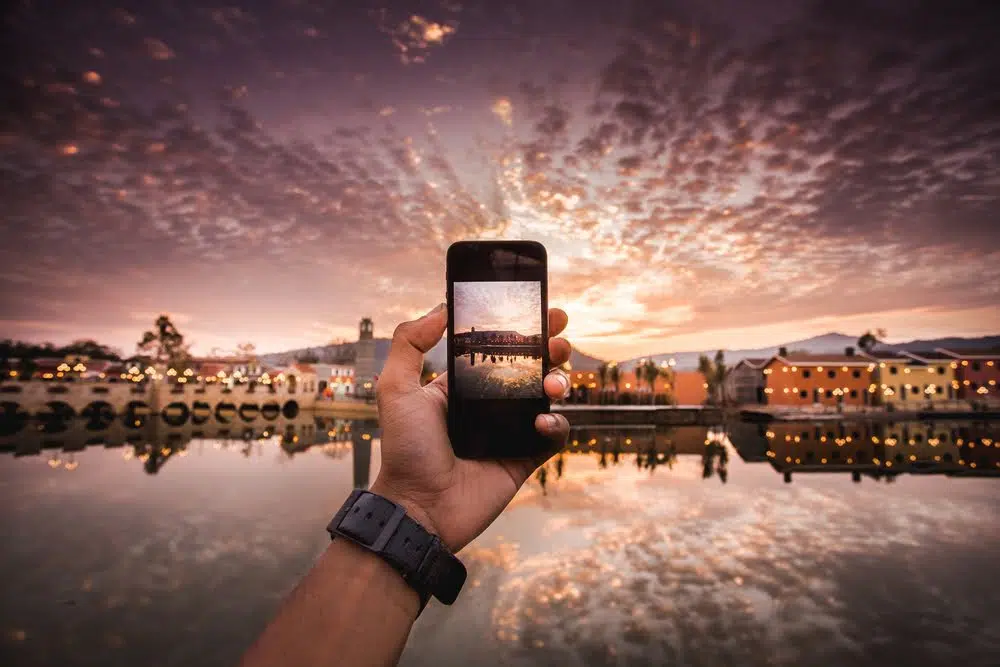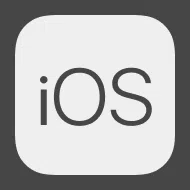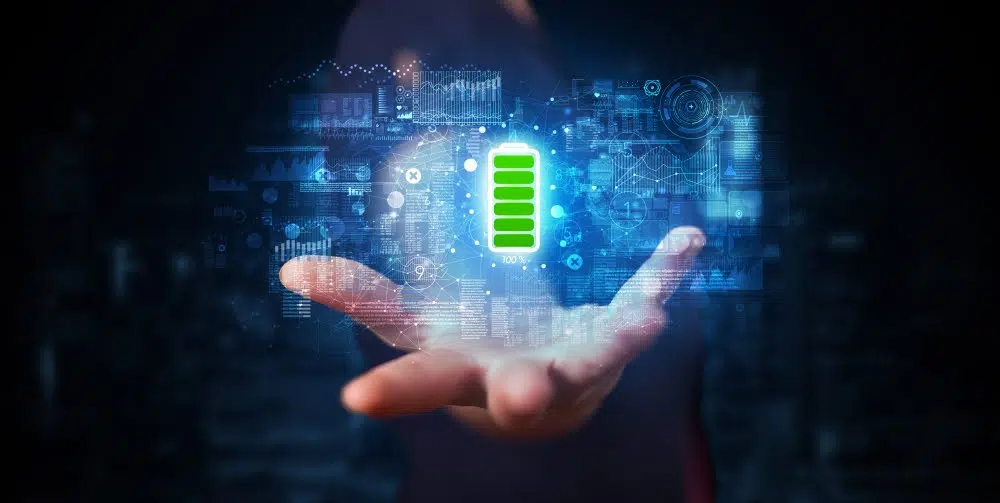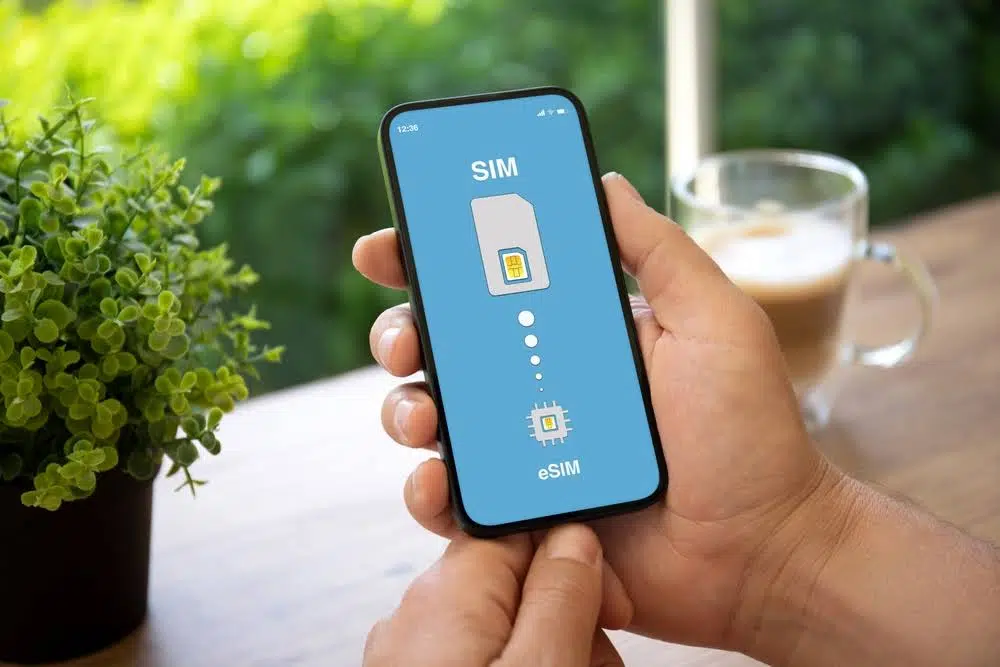
As Apple continues to innovate, each new iteration of the iPhone brings forth a wave of excitement and anticipation among tech and smartphone enthusiasts. The iPhone 13, released in 2021, marked another significant milestone in the lineup. Packed with cutting-edge features like the powerful A15 Bionic chip and advanced camera system, the iPhone 13 raised the bar for what users could expect from their mobile devices.
With the introduction of the iPhone 14 in 2022, the question arises: Should you stick with the tried and tested iPhone 13 or upgrade to the next generation? In this article, we’ll explore these models and compare their key features, performance, and value proposition to help you determine which one suits your needs best.
iPhone 13 vs. iPhone 14: Main Differences
- The iPhone 14’s Photonic Engine makes for better low-light photography.
- The iPhone 14’s Emergency SOS via Satellite allows you to communicate with emergency services in areas without cellular or Wi-Fi coverage.
- The iPhone 14 has an advanced sensor that enables Crash Detection, automatically calling emergency services after a severe car crash.
- While both phones use the A15 Bionic chip, the iPhone 14’s version includes a 5-core GPU for better graphics performance.
- The iPhone 14 boasts improved battery life, providing users with longer usage between charges.
iPhone 13: Key Highlights
- Powerful A15 Bionic chip for fast performance
- 5G connectivity provides fast download and upload speeds
- OLED Display for enhanced visuals
- Ceramic shield front cover for more durability
- Super Retina XDR Display for an immersive viewing experience.
iPhone 14: Key Highlights
- A15 Bionic Chip with 5-core GPU for excellent performance
- Emergency SOS via Satelite for safety
- Crash Detection to automatically call emergency services during crashes
- Enhanced battery life
- Advanced dual-camera system for sharper images.
iPhone 13 vs. iPhone 14: Overview
| Feature | iPhone 13 | iPhone 14 |
|---|---|---|
| Release Date | September 24, 2021 | September 16, 2022 |
| Dimensions | 5.78 x 2.82 x 0.30 in | 5.78 x 2.82 x 0.31 in |
| Weight | 6.14 oz | 6.07 oz |
| Storage Capacity | 128 GB 256 GB |
512 GB 128 GB 256 GB 512 GB |
| Finish Colours | Midnight Starlight Red Green Pink Midnight |
Midnight Starlight Red Yellow Purple Blue |
| Screen Size | 6.1 in (diagonal) | 6.1 in (diagonal) |
| Display | Super Retina XDR display All-screen OLED HDR display True Tone Wide Colour Haptic Touch 800 nits (brightness) |
Super Retina XDR display All-screen OLED HDR display True Tone Wide Colour (P3) Haptic Touch 800 nits (brightness) |
| Resolution | 2532 x 1170 pixels at 460 ppi | 2532 x 1170 pixels at 460 ppi |
| Chip | >A15 Bionic chip | A15 Bionic Chip |
| Water and Dust Resistance | Rated IP68 | Rated IP68< |
| Front Camera | 12 MP True Depth f/2.2 aperture |
12 MP True Depth f/1.9 aperture |
| Rear Camera | <12 MP Wide and Ultra Wide Wide: f/1.6 aperture Ultra Wide: f/2.4 aperture Optical zoom: 2x Digital zoom: up to 5x |
12 MP Main and Ultra Wide Main: f/1.5 aperture Ultra Wide: f2.4 aperture Optical zoom: 2x Digital zoom: up to 5x Sapphire crystal lens cover |
| Video Recording | Cinematic mode (1080p at 30 fps) HDR video recording with Dolby Vision up to 4K at 60 fps 4K video recording at 24 fps, 25 fps, 30 fps or 60 fps 1080p HD video recording at 25 fps, 30 fps or 60 fps 720p HD video recording at 30 fps |
Cinematic mode up to 4K HDR at 30 fps HDR video recording with Dolby Vision up to 4K at 60 fps 4K video recording at 24 fps, 25 fps, 30 fps or 60 fps 1080p HD video recording at 25 fps, 30 fps or 60 fps 720p HD video recording at 30 fps Photonic Engine |
| Battery | Video playback: Up to 19 hours Audio playback: Up to 75 hours |
Video playback: 20 hours Audio playback: Up to 80 hours |
| Charging | Fast charging: Up to 50% charge in 30 minutes Wireless charging (MagSafe and Qi) |
Fast charging: Up to 50% charge in 30 minutes Wireless charging (MagSafe and Qi) |
| Sensors | Face ID Barometer Three‑axis gyro Accelerometer Proximity sensor Ambient light sensor |
Face ID Barometer High dynamic range gyro High-g accelerometer Proximity sensor Dual ambient light sensors |
| Face ID | Yes | Yes |
| Apple Pay | Yes | Yes |
| SIM Card | Dual SIM (Nano-SIM and eSIM) Dual eSIM |
Dual eSIM support14 Dual SIM (nano-SIM and eSIM) |
iPhone 13 vs. iPhone 14 Specs: Complete Comparison
Let’s explore the different features of the iPhone 13 and 14 in more detail:
Design
The design of the iPhone has always been a significant aspect of its appeal, and the transition from the iPhone 13 to the iPhone 14 showcases Apple’s commitment to refining its aesthetic and functional features. Both models maintain the premium build and aesthetic that Apple is known for but with subtle updates and improvements that distinguish the newer model from its predecessor.
Both the iPhone 13 and iPhone 14 maintain the flat-edge design that Apple reintroduced with the iPhone 12, offering a modern and sleek appearance.
In terms of size and weight, the models are remarkably similar:
- iPhone 13: 5.78 x 2.82 x 0.30 in, 6.14 oz
- iPhone 14: 5.78 x 2.82 x 0.31 in, 6.07 oz
Material quality is also made to high standards across both models, with Apple using aerospace-grade aluminum frames and Ceramic Shield fronts that are known for their durability and resistance to drops and scratches. However, the iPhone 14 introduces slight enhancements to the glass and frame’s durability, aiming to offer a more resilient device without altering the overall look and feel.
The physical features, such as the placement of buttons, ports, and the camera layout, remain consistent, preserving the intuitive user experience Apple is known for. Nonetheless, the iPhone 14’s camera system has slight enhancements, slightly affecting the camera bump’s size and appearance to accommodate improved sensors. However, this change is minimal and does not significantly impact the overall design ethos of the device.
Overall, while the iPhone 14 and 13 share a strong design lineage, the latest model offers minor refinements in materials, durability, and colour options, continuing Apple’s tradition of incremental design evolution with each new release.
Display
The displays of the iPhone 13 and iPhone 14 are central to the user experience, offering immersive visuals, vibrant colours, and sharp details that Apple users have come to expect. Both models feature a 6.1-inch Super Retina XDR display, maintaining consistency in screen size that ensures a broad and engaging viewing space for users transitioning between models. The type of screen used in the iPhone 13 and iPhone 14 is OLED, known for its deep blacks and high contrast ratios, enhancing the visual experience whether you’re watching videos, scrolling through photos, or playing games.
Both models offer the same resolution, with 2532 x 1170 pixels at 460 ppi. This pixel density provides crisp and clear imagery, making text sharp and photos and videos appear lifelike.
While the core specifications of the displays remain similar, the iPhone 14 introduces minor colour accuracy and brightness efficiency improvements, offering a more vibrant and energy-efficient display. These enhancements contribute to a slightly better viewer experience, with colours that pop a bit more and a display that is easier to view in various lighting conditions.
Performance
The iPhone 13 is powered by Apple’s A15 Bionic chip with six cores, which already set a high benchmark in smartphone performance upon its release. This chip provides a seamless experience for users, supporting high-end gaming, multitasking, and advanced photography with ease.
Transitioning to the iPhone 14, Apple continued to use the A15 Bionic chip for the base model, but with a crucial differentiation: the iPhone 14’s chip includes an additional GPU core compared to the one used in the iPhone 13. This means that while the core count and basic architecture remain consistent, the iPhone 14 offers enhanced graphics performance. This improvement manifests in smoother visual effects, more responsive gaming experiences, and faster rendering times for video and photo editing applications.
Overall, this means the iPhone 14 delivers a slightly more polished performance in graphics-intensive tasks, making it an appealing upgrade for those who demand top-tier gaming or creative work performance.
Camera
The camera systems on the iPhone 13 and iPhone 14 reflect Apple’s ongoing commitment to photographic excellence, with each iteration bringing enhancements that appeal to both amateur and serious photographers alike. While both models boast powerful dual-camera setups, the iPhone 14 introduces subtle yet impactful improvements that enhance photo and video quality.
- Primary Sensor: Both models feature a 12MP main camera, but the iPhone 14’s sensor is larger, allowing more light capture for better low-light performance.
- Night Mode: This is enhanced on the iPhone 14, offering clearer, more detailed images in dim conditions without sacrificing colour accuracy.
- Photographic Styles and Cinematic Mode: Introduced in the iPhone 13 and refined in the iPhone 14, these features allow for more creative control and higher-quality video production, making every shot and clip look professionally done.
- Photonic Engine: The iPhone 14 introduces the Photonic Engine for significantly improved low-light photography, a feature not present in the iPhone 13.
The iPhone 14’s camera system also benefits from computational photography advancements, including better stabilization and faster processing, which means photos and videos are captured with higher quality and greater ease. For users, this translates to:
- Crisper images with less noise, especially in challenging lighting.
- More dynamic range, capturing details in both shadows and highlights.
- Improved portrait mode shots with more natural bokeh effects.
While the iPhone 13 already offers a high-quality camera experience, the iPhone 14 elevates this further, making it an ideal choice for photography enthusiasts looking to capture moments with more clarity, colour fidelity, and creativity.
Operating System
The iPhone 13 launched with iOS 15, introducing features like Focus mode for customized notifications, Live Text for interactive text in photos, and substantial improvements to FaceTime, including spatial audio and Portrait mode. These features significantly enhanced productivity, communication, and the overall user interface, making iOS more intuitive and personalized.
On the other hand, the iPhone 14 debuted with iOS 16, bringing forward even more innovations. Noteworthy advancements included a customizable Lock Screen, the introduction of Widgets directly on the Lock Screen for at-a-glance information, and improvements to Messages and Mail that deepened the functionality and interactivity of these core apps. iOS 16 also enhanced privacy features, giving users more control over their data and interactions.
Both models are fully compatible with the latest iOS updates, ensuring users can always access the newest features, security enhancements, and system improvements.
Storage
Both models offer the same storage options:
- 128GB: Ideal for average users who stream most of their content and don’t keep an extensive library of photos or videos on their devices.
- 256GB: Suited for those downloading more apps and games and storing a significant amount of media on their phone.
- 512GB: Best for power users who record many high-quality videos, download extensive app libraries, or want to future-proof their storage needs.
This range allows users to choose a size that fits their lifestyle, whether they’re casual smartphone users or power users who need ample space for photos, videos, apps, and more.
Battery and Charging
The battery life and charging capabilities of the iPhone 13 and iPhone 14 are critical factors for users who rely on their devices for daily tasks, entertainment, and communication. Both models have made strides in optimizing battery performance, but the iPhone 14 introduces slight improvements that enhance user experience even further.
The iPhone 13 was praised for its all-day battery life, thanks to efficient power management and the A15 Bionic chip’s energy-saving features. It supports fast charging, allowing users to charge up to 50% in about 30 minutes with a 20W adapter or higher, and also offers wireless charging and MagSafe compatibility.
The iPhone 14 builds on this foundation, maintaining the same fast charging capabilities and MagSafe support but with enhancements in battery chemistry and power management that extend battery life even further. Users of the iPhone 14 can expect slightly longer usage times between charges, which is a pull for people who heavily rely on their devices.
Audio
Both devices offer excellent audio experiences. The hardware responsible for audio output—such as the speakers and internal audio processing capabilities—remains largely consistent between these two models.
In terms of audio formats, both models support a wide range of high-quality formats, including:
- Spatial Audio with Dolby Atmos for a more immersive sound experience, making it feel like the audio surrounds you.
- Lossless Audio in the Apple Music app offers an uncompromised listening experience.
- Wide stereo audio playback enhances the spatial effect and clarity of the soundstage.
Features
Splash, Water, and Dust Resistance: Each model is rated IP68 under IEC standard 60529, which means they are designed to be dust-tight and can withstand submersion in water up to 6 meters for up to 30 minutes. This rating ensures that the iPhone 13 and iPhone 14 are well-equipped to handle everyday encounters with water and dust, from accidental spills to brief immersions. For users, this translates to peace of mind in various environments, whether at the beach, by the pool, or in dusty conditions.
Connectivity: Both the iPhone 13 and iPhone 14 offer comprehensive connectivity options, including 5G support for high-speed internet, Wi-Fi 6 for fast and secure wireless connections, and Bluetooth 5.0 for reliable pairing with a wide range of devices. While the core connectivity features remain consistent, the iPhone 14 benefits from slightly improved 5G bands and performance, ensuring better coverage and faster speeds in more places.
Price Comparison
Upon release in 2021 the MSRP for the 128 GB iPhone 13 was $1,099 (CAD). The iPhone 14 also started at $1,099 (CAD).
In the Certified Pre-Owned market, the value of an iPhone 13 starts in the $600s, depending on the condition and storage option. A used iPhone 14 begins in the mid $800s. Keep in mind that these used prices are subject to change at any time.
* Price updated as of May 2024
Availability
The iPhone 13 and 14 are widely available in new and used conditions, mainly because they are newer models in Apple’s lineup. Mobile Klinik offers these devices in Certified Pre-Owned (CPO) condition—all devices undergo rigorous testing and inspection to meet users’ needs.
What’s The Verdict?
Choosing between the iPhone 13 and 14 depends on your overall needs as a smartphone user:
Best Device Overall
The iPhone 14 edges out as the best device overall, offering incremental improvements across the board, including enhanced camera features, better battery life, and groundbreaking safety features not found in its predecessor.
Best Device for Performance
While both devices share the A15 Bionic chip, the iPhone 14’s slight optimizations and additional GPU core give it a narrow lead in performance, making it the best choice for those who prioritize speed and graphics.
Best Viewing Experience
Both models offer similar display qualities with Super Retina XDR screens, but the iPhone 14’s slight brightness and colour accuracy improvements provide a marginally better viewing experience.
Best for Photography
The iPhone 14 takes the lead in photography thanks to its advanced Photonic Engine and improved low-light performance, making it ideal for photography enthusiasts.
Best Battery Life
With its refined battery chemistry and optimized power management, the iPhone 14 offers the best battery life, ensuring longer usage between charges.
Best Value
While the MSRP of the iPhone 13 and 14 were the same upon release, the iPhone 13 will typically be more affordable in the Certified Pre-Owned market because it’s an older device.
As you decide between the iPhone 13 and 14, consider your unique needs as a mobile user:
- How important are the latest camera features to you?
- Do you require extended battery life?
- Are safety features a priority for you?
- What is your budget?
- Do you use your device for gaming?
- Is having the latest technology necessary for you?
Overall, asking yourself these questions can help you understand your priorities. While the two models are widely similar across the board, the slight improvements in the iPhone 14 might appeal if you like the latest and greatest technology. But, if you’re happy with the advanced features that aren’t quite the best available, the iPhone 13 is still an excellent choice.
Frequently Asked Questions
Is the iPhone 14 worth the upgrade from the iPhone 13?
Whether the iPhone 14 is worth the upgrade depends on your needs and priorities. If you value the latest camera capabilities, extended battery life, and innovative safety features, the iPhone 14 presents a compelling case. However, if your current iPhone 13 meets your needs, the improvements in the iPhone 14 might not justify the cost of upgrading for every user.
Can the iPhone 13 and iPhone 14 run the latest version of iOS smoothly?
Yes, both the iPhone 13 and iPhone 14 can run the latest version of iOS smoothly. Apple designs its software updates to be compatible with older devices, ensuring both models benefit from the latest features, security updates, and performance improvements.
Can you use the same case for the iPhone 13 and iPhone 14?
Yes, you can use the same case for the iPhone 13 and iPhone 14 in most cases, as both models share very similar dimensions and designs. The iPhone 13 and iPhone 14 both feature a 6.1-inch display and have nearly identical height, width, depth measurements, camera placements, and button layouts. This compatibility allows for a wide range of cases designed for the iPhone 13 to fit the iPhone 14 as well.
However, it’s always a good idea to verify the case compatibility with the manufacturer, especially if the case has very tight tolerances or if there are minor differences in camera bump size or thickness between the two models that could affect the fit.
